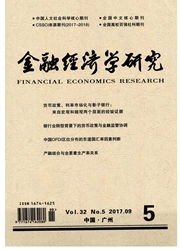

 中文摘要:
中文摘要:
运用Metafrontier—Mamlqusit—Luenberger生产率指数(MML指数)测度了2006~2010年中国88家证券公司的全要素生产率及其分解成分,并对影响全要素生产率的环境因素进行了实证分析。结果表明,在技术落差比率方面,创新类证券公司走势较为平稳,规范类证券公司呈上升的趋势,其它类证券公司则呈现倒“V”型;总体上,中国证券公司的全要素生产率是下降的,只有规范类证券公司MML指数大于1,技术退步是导致中国证券公司全要素生产率下降的主要因素,而纯技术追赶则有拉高中国证券公司全要素生产率的态势;规范类和其他类证券公司的纯技术追赶值明显大于1;股价指数和资产结构对证券公司全要素生产率的提高有促进作用,国际金融危机则对证券公司的全要素生产率有显著的负作用,其他因素对全要素生产率的影响则不显著。
 英文摘要:
英文摘要:
This paper applies Metafrontier-Malmquist-Luenberger productivity index to measure the total factor productivity and its components in a sample of 88 securities firms in China over the period 2006 to 2010 and empirically examines environmental factors of productivity changes. The major conclusions are as follows : ( 1 ) as concerning the technology gap ratio, the tendency of innovation firms go steady, and the standard classes firms escalate, while the other securities firms show a reversed "V" shape. (2)On the whole, the TFP of securities finns decreases slightly, only the standard classes firms go up slightly;TC is the major source of hampering the TFP, while PTCU has positive effect on the TFP. ( 3 ) The standard classes and other securities firms perform well in PTCU. (4) The raising of the stock indexes and asset -liability ratio push forward the TFP of securities firms; however, the international financial crisis has a significantly negative impact on TFP and other environmental factors have insignificant effect.
 同期刊论文项目
同期刊论文项目
 同项目期刊论文
同项目期刊论文
 期刊信息
期刊信息
